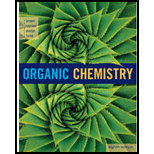
Concept explainers
(a)
Interpretation:
The chemical equation for the reaction of given compound with boron trifluoride has to be given.
Concept Introduction:
Lewis acid: These are substance that donates proton and accepts a pair of nonbonding electrons.
Lewis base: These are substances that accept proton and donate a pair of nonbonding electrons.
(b)
Interpretation:
The chemical equation for the reaction of given compound with boron trifluoride has to be given.
Concept Introduction:
Lewis acid: These are substance that donates proton and accepts a pair of nonbonding electrons.
Lewis base: These are substances that accept proton and donate a pair of nonbonding electrons.
(c)
Interpretation:
The chemical equation for the reaction of given compound with boron trifluoride has to be given.
Concept Introduction:
Lewis acid: These are substance that donates proton and accepts a pair of nonbonding electrons.
Lewis base: These are substances that accept proton and donate a pair of nonbonding electrons.
(d)
Interpretation:
The chemical equation for the reaction of given compound with boron trifluoride has to be given.
Concept Introduction:
Lewis acid: These are substance that donates proton and accepts a pair of nonbonding electrons.
Lewis base: These are substances that accept proton and donate a pair of nonbonding electrons.
(e)
Interpretation:
The chemical equation for the reaction of given compound with boron trifluoride has to be given.
Concept Introduction:
Lewis acid: These are substance that donates proton and accepts a pair of nonbonding electrons.
Lewis base: These are substances that accept proton and donate a pair of nonbonding electrons.
(f)
Interpretation:
The chemical equation for the reaction of given compound with boron trifluoride has to be given.
Concept Introduction:
Lewis acid: These are substance that donates proton and accepts a pair of nonbonding electrons.
Lewis base: These are substances that accept proton and donate a pair of nonbonding electrons.
Want to see the full answer?
Check out a sample textbook solution
Chapter 4 Solutions
ORGANIC CHEMISTRY-OWL V2 ACCESS
- Please help me solve this reaction.arrow_forwardIndicate the products obtained by mixing 2,2-dimethylpropanal with acetaldehyde and sodium ethoxide in ethanol.arrow_forwardSynthesize 2-Ethyl-3-methyloxirane from dimethyl(propyl)sulfonium iodide using the necessary organic or inorganic reagents. Draw the structures of the compounds.arrow_forward
- Synthesize 2-Hydroxy-2-phenylacetonitrile from phenylmethanol using the necessary organic or inorganic reagents. Draw the structures of the compounds.arrow_forwardSynthesize N-Methylcyclohexylamine from cyclohexanol using the necessary organic or inorganic reagents. Draw the structures of the compounds.arrow_forwardSynthesize N-Methylcyclohexylamine from cyclohexanol using the necessary organic or inorganic reagents. Draw the structures of the compounds.arrow_forward
- If possible, please provide the formula of the compound 3,3-dimethylbut-2-enal.arrow_forwardSynthesize 1,4-dibromobenzene from acetanilide (N-phenylacetamide) using the necessary organic or inorganic reagents. Draw the structures of the compounds.arrow_forwardIndicate the products obtained by mixing (3-oxo-3-phenylpropyl)triphenylphosphonium bromide with sodium hydride.arrow_forward
- We mix N-ethyl-2-hexanamine with excess methyl iodide and followed by heating with aqueous Ag2O. Indicate the major products obtained.arrow_forwardIndicate the products obtained by mixing acetophenone with iodine and NaOH.arrow_forwardIndicate the products obtained by mixing 2-Propanone and ethyllithium and performing a subsequent acid hydrolysis.arrow_forward
 Macroscale and Microscale Organic ExperimentsChemistryISBN:9781305577190Author:Kenneth L. Williamson, Katherine M. MastersPublisher:Brooks Cole
Macroscale and Microscale Organic ExperimentsChemistryISBN:9781305577190Author:Kenneth L. Williamson, Katherine M. MastersPublisher:Brooks Cole General, Organic, and Biological ChemistryChemistryISBN:9781285853918Author:H. Stephen StokerPublisher:Cengage Learning
General, Organic, and Biological ChemistryChemistryISBN:9781285853918Author:H. Stephen StokerPublisher:Cengage Learning Chemistry & Chemical ReactivityChemistryISBN:9781337399074Author:John C. Kotz, Paul M. Treichel, John Townsend, David TreichelPublisher:Cengage Learning
Chemistry & Chemical ReactivityChemistryISBN:9781337399074Author:John C. Kotz, Paul M. Treichel, John Townsend, David TreichelPublisher:Cengage Learning Chemistry & Chemical ReactivityChemistryISBN:9781133949640Author:John C. Kotz, Paul M. Treichel, John Townsend, David TreichelPublisher:Cengage Learning
Chemistry & Chemical ReactivityChemistryISBN:9781133949640Author:John C. Kotz, Paul M. Treichel, John Townsend, David TreichelPublisher:Cengage Learning Chemistry for Today: General, Organic, and Bioche...ChemistryISBN:9781305960060Author:Spencer L. Seager, Michael R. Slabaugh, Maren S. HansenPublisher:Cengage Learning
Chemistry for Today: General, Organic, and Bioche...ChemistryISBN:9781305960060Author:Spencer L. Seager, Michael R. Slabaugh, Maren S. HansenPublisher:Cengage Learning




